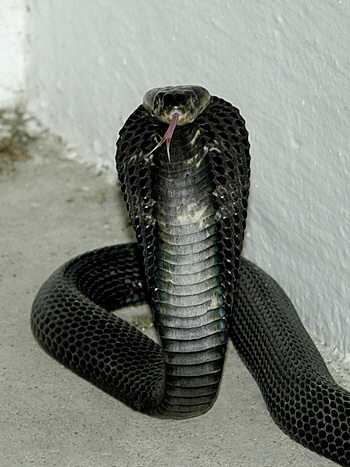- The Southeast Asian country is the world’s top palm oil producer. It also ranks No. 2 in snakebites globally.
- The species of serpent that has spread in Indonesia’s oil palm and rubber plantations is the Sumatran cobra.
- There is no available antivenom for Sumatran cobra bites. Plantation workers often die from them.
It was a sunny afternoon in North Sumatra when Muhamad Syahrial, a worker on a rubber estate in the Indonesian province, spotted a slithering snake among the children at play in his backyard.
Having labored on plantations for decades, Syahrial instinctively knew the creature was dangerous. He cornered the snake, which had stood up and opened its hood, and beat it to death with a piece of bamboo.
“It was a cobra,” he said.
For a field hand like Syahrial, encounters with cobras are common. “When I worked in Riau [province], the cobras were golden, but here they are black or sometimes brown,” he told Mongabay.
Syahrial was referring to the Sumatran cobra (Naja sumatrana), also known as the equatorial spitting cobra. This slim, medium-sized serpent can permanently blind its enemy by spitting venom in its eyes.
The cobra’s bite is often fatal. Its fangs release cardiotoxin and neurotoxin, chemicals that strike the heart and brain within hours.

Sumatran cobras are thriving across Indonesia’s ubiquitous oil palm and rubber plantations. Newspaper reports about bites and about the snakes’ incursions into human habitations have become frequent. In May, a security guard at a Belgian plantation company in North Sumatra died within two hours of a cobra bite. Reports have also trickled out of Kalimantan, the Indonesian part of Borneo island.
Indonesia ranks No. 2 in snakebites globally, with more than 11,000 deaths per year, according to the International Society of Toxinology.
Writer Janaki Lenin, wife of the herpetologist Romulus Whitaker, took note of this phenomenon while hunting for king cobras (Ophiophagus hannah) with Whitaker in Central Kalimantan.
In a blog post titled “Oil palm plantations are a paradise for Sumatran cobras,” Lenin said she had found 12 cobras in 10 days of exploring the plantation. She also heard that two workers had been spat in the eyes by a cobra coiled up in a tree whose fruit they were harvesting. A doctor on the estate treated them successfully, she wrote.
Sumatran cobras “are incredibly common here,” she wrote, “…even more common than spectacled cobras [Naja naja] are in rice fields back home [in India].”

The cobra’s paradise
There appears to be no research on the relationship between Indonesia’s rapid plantation expansion — the country is the world’s top producer of palm oil, found in everything from chocolate to cosmetics and laundry detergent — and the Sumatran cobra’s spread.
Lenin suspects the phenomenon is due to the ecology of oil palm plantations, where rats feed on the enormous, oily palm fruits and become major pests. The snakes feed on the rats.
The IUCN Red List has assigned the Sumatran cobra to its Least Concern category in part because “the snake is well adapted to oil palm and rubber plantations.”
Amir Hamidy, a herpetologist from Indonesian Institute of Sciences (LIPI), a Jakarta-based thinktank, said the cobras’ prevalence demonstrated how oil palm and rubber estates could disturb the natural balance of a rainforest ecosystem.

“In a highly diverse rainforest, populations are controlled and every species of plant and animal has its own function,” he explained. “But once this ecosystem is transformed into a monoculture plantation, this balance will be disturbed.”
Oil palm estates provide cobras with food, while the humid, dense canopies of rubber trees give them shelter, according to Hamidy. But although the cobras are thriving inside the plantations, he said, “they like to forage near human settlements where there’s even more prey to hunt, such as chickens and other farm animals.”
No available antivenom
The problem is exacerbated by a global shortage of antivenom. High production costs, poor data on the number and type of snakebites, and deficient distribution and regulation policies have caused pharmaceutical companies like Sanofi Pasteur to stop making drugs like Fav-Afrique, used to treat snakebites in sub-Saharan Africa, according to the World Health Organization.
In Indonesia, according to Hamidy, the only available snake antivenom is a serum called SABU, produced by state-owned vaccine maker Biofarma. But the drug can only treat bites from the Javan sptting cobra (Naja sputatrix), Malayan pit viper (Calloselasma rhodostoma) and banded krait (Bungarus fasciatus).
“There is no antivenom for Sumatran cobras,” Hamidy said.
Indonesia’s health ministry, he added, does not even compile data on snakebites from public health centers and hospitals.
“It means the government ignores snakebite cases, which is so ridiculous.”
Far from the capital, Syahrial, the plantation worker, is unaware of Hamidy’s concern. He has his own way to overcome the problem: kill a cobra whenever he spots one.
“The snake is too dangerous and we have to protect our children,” he said.

Banner photo: A Sumatran cobra. Photo by 1stopborneo.
